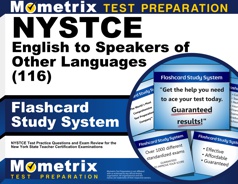The New York State Teacher Certification Exams program (NYSTCE) was designed for teachers in New York State to ensure proficiency in specific educational areas. The NYSTCE English to Speakers of Other Languages exam is designed for prospective ESOL teachers in the state of New York.
Click “Start Test” above to take a free NYSTCE English to Speakers of Other Languages practice test, and check out our premium-quality NYSTCE test prep resources by clicking the links below!
NYSTCE ESOL Exam Outline
The NYSTCE English to Speakers of Other Languages exam contains 90 selected-response questions and one constructed-response question, and you will be given a time limit of 3 hours and 15 minutes.
The exam is split into seven competencies:
1. Learning and Language Learning (13%)
The questions in this competency are designed to assess your knowledge and skills pertaining to the following:
- Current theories and research in home-language and new-language acquisition
- Differences between general-academic, social, and discipline-specific language
- Stages and sequences in new-language acquisition
- The role and importance of transference in new-language acquisition
- Cognitive, metacognitive, and metalinguistic processes involved in learning a new language
- Distinctions between the levels of English language proficiency as defined by NYSED
- Sociolinguistic concepts
- The interrelationship between culture and language
- Current theories and research in literacy development
- Identifying challenging aspects of English
2. Knowledge of English Language Learners (13%)
The questions in this competency are designed to assess your knowledge and skills pertaining to the following:
- English Language Learners’ diverse linguistic abilities
- English Language Learners’ diverse learning strengths, interest, needs, and experiences
- English Language Learner subpopulations
- Distinctions between the characteristics of English Language Learners in the process of new-language acquisition and acculturation
- Evaluating and using a range of resources
- Sociocultural variables
- Cross-cultural differences in cultural perspectives and practices
- Creating a culturally responsive classroom and school environment
- Cultural differences in communication styles
- Individual learner variables that may influence language development and academic achievement
- Social and political variables that may influence language development and academic achievement
3. ESOL Instructional Planning, Practices, and Assessment (13%)
The questions in this competency are designed to assess your knowledge and skills pertaining to the following:
- Current research- and evidence-based approaches to ESOL instruction
- Promoting English Language Learners’ beginning and ongoing reading development in English
- Relevant learning standards
- Establishing goals and expectations for students that are aligned with relevant learning standards for language development and content learning
- Selecting and designing appropriate and culturally responsive curricular materials
- Evaluating, selecting, modifying, and using a variety of curricular materials to promote student success in meeting learning goals
- Effective classroom communication practices that maximize understanding and learning
- Promoting active engagement in learning
- Creating, organizing, and managing a respectful, safe, and supportive student-centered learning environment
- Principles of assessment
- The importance of using multiple measures of assessment
- Analyzing, interpreting and using assessment results and other relevant data to plan instruction
- Communicating assessment results to stakeholders
- Knowledge of issues that can affect the validity of assessments
- Allowable testing accommodations as defined by NYSED
- Interventions under the New York RtI model and/or AIS
- Federal accountability measures for English Language Learners
4. Instructing English Language Learners in English Language Arts (14%)
The questions in this competency are designed to assess your knowledge and skills pertaining to the following:
- NYSLS for English Language Arts & Literacy and the New York State Bilingual Common Core Initiative–New Language Arts Progressions
- Utilizing students’ home language(s) to promote development in English language arts
- The dimensions of communicative competence
- Supporting and scaffolding student achievement of relevant learning standards related to English speaking, listening, and foundational English literacy skills
- Prioritizing foundational English literacy skills for English Language Learners in early stages of language acquisition
- Supporting and scaffolding English Language Learners’ achievement of relevant learning standards related to comprehending complex informational and literary texts in English
- The organizational structure and key characteristics of informational and literary texts
- Relevant learning standards related to evaluating, synthesizing content from, and responding to complex informational and literary texts in English
- Relevant learning standards related to using the writing process to produce a variety of texts for a variety of purposes in English
- Relevant learning standards related to producing text-based written responses and research-based writing from sources in English
- Relevant learning standards related to the development of standard English conventions
- Relevant learning standards related to the development of English vocabulary
- Assessment instruments and techniques for assessing English Language Learners’ listening, speaking, reading, writing, language conventions, and vocabulary
5. Instructing English Language Learners in the Content Areas (14%)
The questions in this competency are designed to assess your knowledge and skills pertaining to the following:
- State academic learning standards
- Prioritizing foundational content knowledge and skills for English Language Learners appropriate to the grade level and language-proficiency level of the student
- The interdependence of language learning and content learning
- Discipline-specific and interdisciplinary features of academic discourse and academic language
- Making subject matter accessible and comprehensible to English Language Learners
- Connecting English Language Learners’ prior understanding and experiences to new knowledge
- Verbal, procedural, metacognitive, visual, and instructional scaffolding
- Promoting English Language Learners’ development of learning skills
- Connecting concepts across disciplines and engaging English Language Learners in critical and innovative thinking and collaborative problem solving related to real-world contexts
- Assessing English Language Learners’ discipline-specific language and literacy development and content-area learning
6. ESOL Professional Environments (13%)
The questions in this competency are designed to assess your knowledge and skills pertaining to the following:
- New York State Commissioner’s Regulation Part 154
- Key court cases and legislation
- Characteristics, goals, and research on the effectiveness of various models and types of programs for English Language Learners
- Current developments within the field of ESOL
- Using self-reflection and stakeholders’ feedback to inform and adjust instructional practices and professional behavior
- Setting goals for and engaging in ongoing professional development
- Communicating and collaborating with students and their families
- Serving as a professional resource in the school community
- Communicating and collaborating with colleagues and community members to provide English Language Learners with comprehensive, challenging educational opportunities
- Advocating for English Language Learners’ full, equitable access to school resources
- The importance of advocacy
7. Analysis, Synthesis, and Application (20%)
This competency contains the only constructed-response question on the exam. You will be asked to write a short analysis of design instruction that helps students achieve a specific learning goal.
Check Out Mometrix's NYSTCE English to Speakers of Other Languages Study Guide
Get practice questions, video tutorials, and detailed study lessons
Get Your Study Guide
Exam Registration
To register for the NYSTCE English to Speakers of Other Languages exam, you will need to create an NYSTCE account online and complete the registration process there. It is recommended that you complete the registration process at least 30 days before you take the exam.
During this process, you will be asked some questions about your educational history, as well as your current education level, first language, matriculation status, and the education code for the NYC Department of Education program type you are associated with.
The examination fee is $122.
Test Day
You should arrive at the testing center about 15-30 minutes earlier than the scheduled exam time on test day. Once you arrive, you will be asked to sign in and provide a valid form of government-issued photo ID.
Before the exam begins, you will be asked to place all personal items (cell phone, keys, wallet, bags, accessories etc.) in a locker outside the testing room, or you may be asked to leave them in your car.
Once the test begins, you will be allowed to take breaks. However, the timer will not be stopped during your break, so use your break time carefully.
How the Exam is Scored
Your total NYSTCE English to Speakers of Other Languages score is based on the number of questions you answered correctly, which is then reported as a numerical figure in the range of 400-600. To pass the exam, you must achieve a scaled score of 520.
You should receive your test results roughly 2-4 weeks after taking the exam. When you receive your score report, you will see your total score, your pass/fail status, and your scores for each subarea of the test.
Check out Mometrix's Flashcards
Get complex subjects broken down into easily understandable concepts
Get Your Flashcards
FAQs
Q
How many questions are on the NYSTCE ESOL exam?
A
There are 91 questions on the exam.
Q
How long is the NYSTCE ESOL exam?
A
The time limit for the exam is 3 hours and 15 minutes.
Q
What is the passing score for the NYSTCE ESOL exam?
A
To pass the exam, you must achieve a scaled score of at least 520.
Q
How much does the NYSTCE ESOL exam cost?
A
The examination fee is $122.
